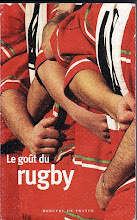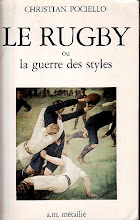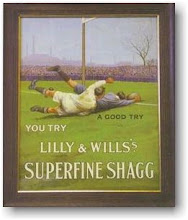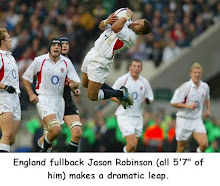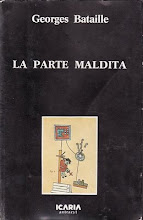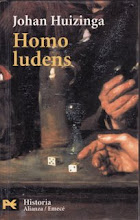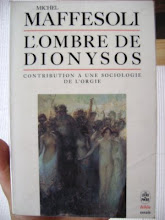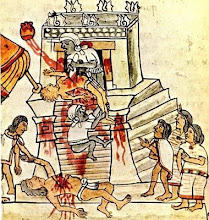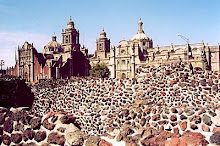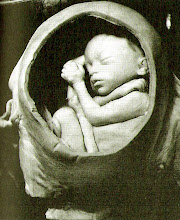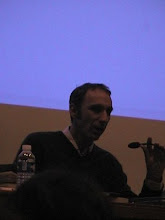Rugby was born in the British region of this name toward 1823 during a football match when suddenly a player decided to score a goal with the hand. With this transgression of the rules would begin not only a sport where two teams would fight for an oval ball and not for a spherical one, but the team's sport in the Anglo-Saxon world par excellence. Rugby has been interpreted by the specialist as one of the most intelligent and complete of the team’s sports where body and mind conciliate the principal Western duality. Rugby also has been considered to have a moral quality that set it above all sports (according to its players and philosophers).
“Violence is an integral part of Rugby game”. Nevertheless, according to the Victorian tradition of the British Justice where every judiciary cases should be discussed without a written Constitution, Rugby, as it born during the Victorian period, didn’t need at first of referees and the rules were decided through discussion between the captains of the two teams until 1885. This sportive practice was supposed to be a perfect application of the British gentlemanly ethics.
With their emblematic colors and their mythical stadiums, Rugby teams are worldwide recognized by their symbols: Rooster (France), clover (Irland), leek (Gales), rose (England), thistle (Scotland), fern (All Blacks of New Zealand), puma (Argentina), antelopes (Springboks); enigmatic colors as red and gold for the Dragons of Perpignan… Looking through the Rugby of five Nations, I wonder why this game has been developed in so different countries… may be a kind of protestant evangelization. Rugby is known as the king of the sports, indispensable place of party that the church is not. In South Africa for example, Rugby has become the substitute of the war to liberate and to discipline the violence, giving an identity to a whole country.
I have checked it out some affirmations to think about the great musement that Rugby could means for players, coaches, writers, philosophers and journalists. This selection is a result of a heterological point of view about knowledge and opinions on Rugby. I have refered above those ones that have captured my attention as they talk about Rugby not only as a successful media sport phenomena, but as a ritual practice full of significances: as a way of being, as a secular religious substitute for many people involved with its incantatory practice: players and spectators...
I refer also in this blog some data on human evolution that fascinated Bataille and helped him to understand phenomena such Art, Eroticism, Religion and Play. Consecuently I refer an own perspective in what the notion of Musement used by Charles Pierce could signify in the context of heterological studies related to a French tradition of “thinking the Excess”, viewed through an american gaze of an Erasmus Mundus student, me or we (multiple voices in me), as you prefer…
Excess, ritual activity and evil’s homeopathisation
This kind of ritual domestication of the violence present in Rugby is just what the sociologist Michel Maffesoli after Nietzsche, Bataille, Mauss and Durkheim calls poetically an “Evil’s homeopathization”. As everyone knows, this type of traditional medicine functions under the principle that a little controlled quantity of the same substance/poison that provokes an illness (the same principle works in allergology treatments as I have tried) permits sickness self-healing. In that sense, Georges Bataille understood metaphorically excessive and heterological processes in societies as collective healing procedures.
These bataillean ideas on Heterology began to be known by a very little contribution of the author to a volume of the Cahiers de la république des letters, des sciences et des arts (1928). His article was entitled “Extinct America” and was published for the commemoration of the first major European exhibition of pre-Colombian artefacts. Bataille knew just a little about those cultures, but a friend of him called Alfred Métraux, specialist in the ethnography of Latin America suggested him some books, principally, The History of the Conquest of Mexico, The History of the Conquest of Peru and the famous Bernardino de Sahagún’s General History of the Things of New Spain. With these few books Bataille began his amazing work.
Reality demonstrates that humans, biologically, psychologically and socially, share an innate necessity of healing rituals and narratives to accompany them. Nowadays there are many studies that suggest that a strong religious faith could prolong life and also heal many diseases. How does bodies are penetrated by symbols???
Aztec mass-sacrificial practices demonstrate the possibilities of such strong religious faith. By sacrifying hundreds of prisoners they believed that solar deities could be feed with blood and indeed, human life could be perpetuated. Through their astronomical estimations, they thought that they were living the last solar cycle and after it, world’s destruction would arrive. Specialist today argues that based on their estimations, solar death would arrive in this decade, but in reality nobody knows profoundly about these mathematical calculs as this testamentary knowledge was almost completely destroyed by Spaniards. Bataille, coming from a classical-cartesian culture such as France, was fascinated by these belief
I can not imagine any warrior (Aztec or rugbyman) that does not have a profound sense of Sacrality, as in every combat, real or simulated, there is always a obscure belief related to a supernatural force that determinates the victory or the defeat. At first, Aztecs were a nomadic people that travelled hundreds of kilometers from a mythical place in North Mexico called Aztlán until they found the symbol that once an oracle has signaled to be the best place to construct the center of their empire: an eagle would be standing on a cactus eating a snake. Imagine the force and the religious faith they should have in their gods to keep such travel full of combats, hunger, sickness, death. I suggest that Catholicism has profited from this profound religious sense of the Mexican people to establish since those days an almost totalitarian cult. Of course they had to adapt many aspects of that religion to some of the inner native religious senses of Mexican peoples (as Aztecs were only one of the fifty-two ethnical groups that remains on Mexican territory); polytheism has been adapted under canonization of multiple saints, for example. As one travel into Mexico, it is advertised the inexistence of a total cultural hegemony and that a Mexican Nation is in a real sense, a myth constructed by intellectuals and politicians during the XIX century.
This heterological image of an eagle standing on a cactus and eating a snake has been the national symbol for centuries and probably the one that Bataille studied at first as he worked with medals and monies no longer in circulation at the National Library (this study is known as numinastics and the author worked on it around 1926). Today the sacred place that this symbol would indicated once for the Mexicans is almost completely destroyed under and next a monstrous construction of a baroque cathedral constructed under Spanish catholic orders. A little beat of golden exuberance can be appreciated there nowadays; Aztec gods and goddesses were transformed into catholic decorations. Once there was the great Temple of the great Tenochtitlan, city of Huitzilopochtli, other son of the Sun. There was also a Great Mother’s worship, of Coatlicue, related to the underground forces as well as to growing corn. But there is another deity, probably the most heterological one called Tezcatlipoca, “fuming mirror” who represent the Otherness, the unknown Sun’s son whose stories remains obscure. Almost none talks about him nowadays...
As an Erasmus Mundus student enrolled in a Master specialized on Heterology and obligated to come back to my country just after finishing my 1rst. Semester at the University of Perpignan because of official procedures in order to get a students visa from the Portuguese Embassy in Mexico, staying at home and having to write a paper on Rugby, I realized that, even though I got many books on Rugby, watched many matches of the last World Cup in France, I could not assimilate Rugby’s Musement. Probably because I did not know the rules of the game or/and I do not have any affective link with it as in my culture is totally unknown. Nevertheless, through reading Bataille’s works such La part maudite or Les larmes d’Eros; and reading again the Popol Vuh, the maya-quiché bible during my several half-times of more than a hour in the Subway between the Portuguese Embassy (North of Mexico City), the city’s downtown where lay almost every government’s offices and my house (South of Mexico City); and taking a look at popular daily life of one of the biggest cities of the world, I realized that Rugby is not so far from the secular religious excitement that football provokes in my country. Football teams like “America” property of Televisa, one of the biggest television chains of Latin America, or Pumas, the University’s team, or Chivas, from the beautiful city of Guadalajara, are also worshipped next to the Virgin of Guadalupe or Jesus Christ. As my close family is composed only by women who do not enjoy watching “classical” football match on Sunday, personally, I do not feel any kind of empathy with this sport as with Rugby (I only enjoy World Cups and I think it has to do with a very personal visual Musement that comes from watching how national teams win or loss), but I realized how important could be for others and also “sacred time” , for example my uncle who has worked for thirty years in a football’s newspaper only because he loves Football, his daughter is called America because it is the name of his preferred team... that newspaper curiously is the one with the biggest number of daily copies in circulation in Mexico City. Football is a public affair, more important for the public opinion than politics. Faith in Christianity redemption is shared many times with faith in footballs players one.
All this to say that, even though I could not assimilate Rugby’s sense, precisely not assimilating is one of the purposes of heterological perspectives. Otherness should remain as Radical Alterity, even if we try to think about it, always its final sense should escapes from our hegemonic thought. If not, then we are not walking on a heterological field. Rejection or fascination are the main reactions to heterological processes. Bataille has proposed us with his work to explore the roads of rational thought, forcing it extremely to its limits. He remembered us the response of one of the greatest philosophers of Western culture, Georg Wilhelm Friedrich Hegel, to his own rationalist consciousness; as he was realizing a heterological consciousness escaping from his system, he confessed to a friend by a letter that if he would continue he surely would drive mad, so, Hölderlin’s friend decided to close his system and dedicate his days to repeat his courses and to play cards... Go farer is dangerous for mental sake. Maybe Hölderlin, Nerval or Nietzsche took the risk of the heterological vision with a costly payment. Nobody can sinks completely into Heterology, madness or death are its closest manifestations as we can realized, but the problem remains that in these two cases, there is no return to consciousness’ life and the baitallean way is finally an invitation to think, no to drive mad or die, even if his invitation consists in thinking in a different way, a kind of a slowly brain’s gymnastic training running through the possibility and the impossibility, the rational and the irrational, the cultural heritage and the biological principles, briefly, through the crossroads of human activity and inactivity: from sexual reproduction, eroticism and sacrifice to meditation, inner experiences (related to Musement), literary writing, passing by economics, politics, anthropological data, aesthetics, etc.
- Georges Bataille, La part maudite. Essai d'économie générale, Les Éditions de Minuit, 1949. Tr. Francisco Muñoz de Escalona).
- René Girard, La violence et le sacré, Paris, Hachette, 1970.
- Michel Maffesoli, La part du diable. Précis de subversion postmoderne, Paris, Flammarion, 2002.
- Vincent, Jean-Didier, La chair et le diable, Paris, Odile Jacob, Sciences, 1996.
-Tony Collins. “Violence, Gameship and the Amateur Ideal in Victorian Middle-Class Rugby” in -Mike Huggins (ed). Disreputable Pleasures. Less Virtuos Victorians at Play. London, Frank Cass, 2004. Ch. 8.









